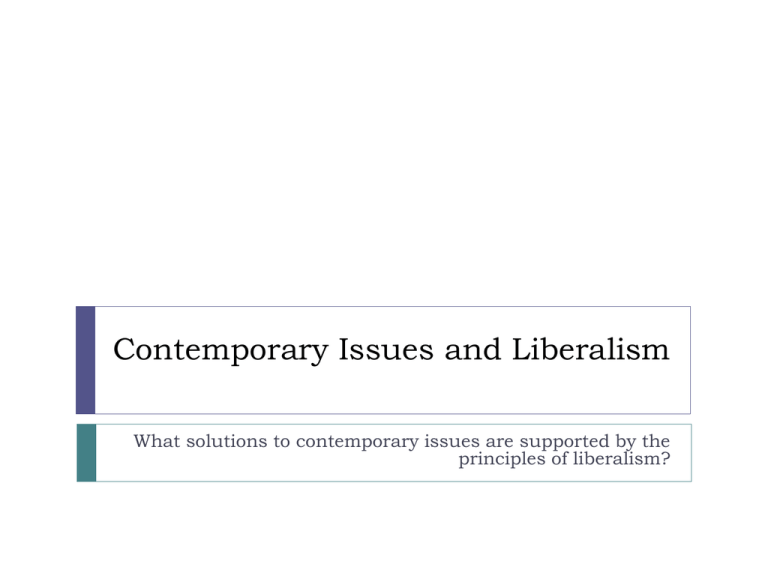Contemporary Issues and Liberalism
advertisement

Contemporary Issues and Liberalism What solutions to contemporary issues are supported by the principles of liberalism? Key Concepts Consumerism Unanticipated Consequences of Liberalism Environmental Movements China and India: 21st Century Economic Miracles Pandemics Water Shortages Reference: pages 417-436 Consumerism Refers to consumer spending, a preoccupation with consumer goods and their acquisition, display of things in order to denote status A product of the success of following classical liberal principles Classical Liberalism created economic growth whereas Modern Liberalism can be seen as an attempt to suggest solutions to the problems caused by laissez-faire principles The impacts of consumerism, both positive and negative, are very significant to all aspects of our lives, as well as to our planet. Equally important is examining the underlying system that promotes certain types of consumption and not other types. Spending Habits Do you think the principles of liberalism helped create the disparity apparent in the tables? Do you think liberal governments should do something to address this issue? What? Area of Spending US $Billions per year Cosmetics in USA 8 Ice Cream in Europe 11 Perfumes in Europe and USA 12 Pet food in Europe and USA 17 Business Entertainment in Japan 35 Cigarettes in Europe 50 Alcoholic drinks in Europe 105 Narcotic Drugs in the world 400 Military spending in the world 780 What do the dollar amounts tell you about consumption priorities? Is there anything wrong with spending money on cosmetics or pet food? Area of Spending US $Billions per Year Basic education for all 6 Water and sanitation for all 9 Reproductive health for all women 12 Basic Health and nutrition for all 13 Consumerism How can liberal democracies take action to address issues related to consumerism? Recycle Fees for Products In Alberta each year, Albertans throw out 100,000 computers and 200,000 TVs. There is now a recycling fee for those items ($45 TV, $12 computer). While the fees collected assist in addressing some negative consequences of consumerism, government actions do not directly discourage or prohibit the purchasing of goods by individuals Unanticipated Consequences of Liberalism 3 Key Unanticipated Consequences of economic freedom and development Wealth and resource development produced by economic liberalism did not benefit many of the people in former colonies (in Asia, Africa, and South America) Citizens of colonized countries were not treated in ways that reflected the principles of liberalism Differential laws regarding property ownership and land, access to health care and education has often restricted development. A legacy of racism, alienation, instability and anger resulted Such feelings have also created conditions that support violence, illiberalism, and terrorism. However… People seem willing to address these inequalities. What other remedial actions could be taken to “fix” the unanticipated consequence of liberalism? Environmental Change and Action In response to environmental change many individuals and groups have resorted to activism to focus media attention on problems caused by industry and societal practices (for example, air pollution from cars and consumerism). The dilemma for liberal democracies: How can they support principles of liberalism such as economic and personal freedom while also promoting the modern liberal principle of a high quality of life for all members of society? Climate Change Kyoto: What’s the deal? Agreement reached at an international convention to reduce greenhouse gases First and only binding international agreement that includes specific goals for individual countries to reduce their greenhouse gas emissions In 2004, Liberal PM Paul Martin, announced a broad plan for dealing with greenhouse gases, however (a common complication in liberal democracies) is that the Conservative, under Harper, took power in 2006. Harper instituted a new climate change plan focusing on additional consultations with industry and business Kyoto: Canada Results (News Article) For years, a succession of Canadian governments have dithered on the climate-change file. The results are in: Canada's greenhouse-gas emissions are growing faster than ever. In 2007, according to new data released from Environment Canada, Canada hit a record high: 747 megatonnes of carbon-dioxide equivalent. That was up four per cent over 2006. The sudden increase can be explained, in part, by the fact that the winter was milder in 2006 than in 2007. But that doesn't explain the fact that since 1990, Canada's emissions have been climbing steadily. This country promised, in the Kyoto agreement, to cut its emissions to six per cent below 1990 levels. Instead, it raised them to 26 per cent above 1990 levels. If this is what it looks like when Canada makes an effort, it's scary to imagine what our emissions might be today if we hadn't tried at all. Indeed, in some sectors, emissions have declined, proving the efficacy of technological and cultural innovation. Residential emissions have stayed at 1990 levels, largely because of more efficient furnaces and buildings. There have been great successes in industrial processes, and emissions from the whole industrial sector decreased. Emissions from cars have decreased by about six megatonnes since 1990. But emissions from SUVs and trucks increased by a whopping 44 megatonnes over the same period. Agriculture has been another major contributor to Canada's greenhouse gases, accounting for seven percentage points of the overall increase since 1990. Environment Canada blames the growing market for meat, and the increase in the use of synthetic nitrogen fertilizer. And then there are the tar sands. Mining, fossil-fuel production and electricity production were all major contributors to the increase in emissions since 1990. Even "fugitive releases" (pipeline leaks, etc) increased by 22 megatonnes between 1990 and 2007. http://www.ottawacitizen.com/Technology/wrong+direction/1570792/story.html








